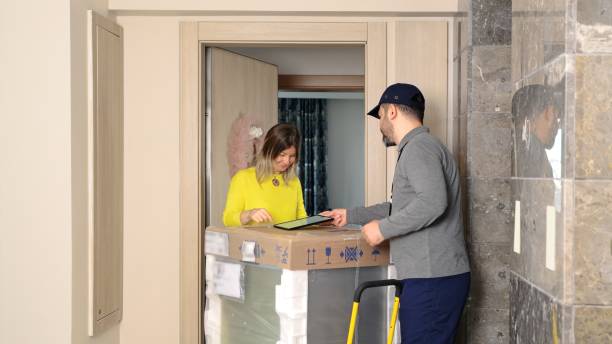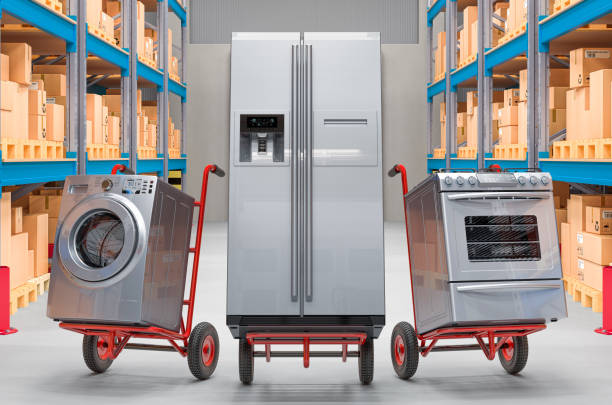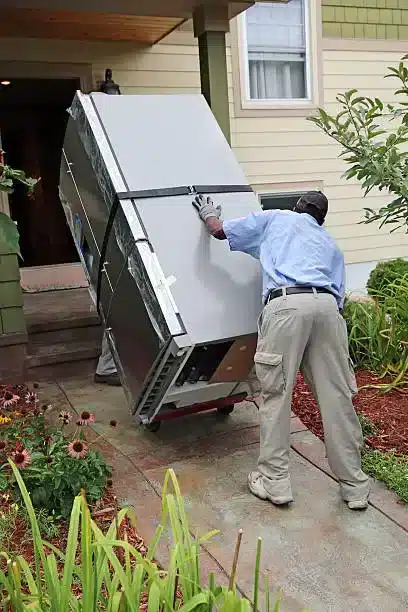If you’re planning to move or relocate your upright freezer, you might be wondering how to do it safely and without damaging your appliance. After all, upright freezers are heavy, bulky and delicate machines that need proper care and handling. In this post, we’ll share some tips and tricks on how to transport an upright freezer safely, whether you’re moving it across the room or across the country.
The safest way to transport an upright freezer is to keep it in the upright position at all times. If this is not possible, lay it down on the compressor side of the unit and let it stand upright for at least 24 hours before plugging it in.
Why You Should Keep Your Upright Freezer Upright
Upright freezers have a cooling system that consists of a compressor, a condenser, an evaporator and refrigerant. The refrigerant is a liquid that circulates through the system and absorbs heat from the freezer interior. The compressor is the part that pumps the refrigerant and creates pressure.
When you tilt or lay down your upright freezer, you risk disturbing the refrigerant flow and causing it to leak into the wrong parts of the system. This can damage the compressor, reduce the cooling efficiency and shorten the lifespan of your freezer. Additionally, you might also cause oil from the compressor to seep into the cooling pipes and clog them.
That’s why it’s best to keep your upright freezer upright when transporting it. This way, you prevent any unwanted movement of the refrigerant and oil and ensure that your freezer works properly when you plug it in.

How to Transport an Upright Freezer Safely
If you need to transport your upright freezer, here are some steps you should follow to do it safely:
- Disconnect the power cord from the wall outlet. You don’t want to risk any electric shock or fire hazard when moving your freezer.
- Remove all the food, shelves, drawers and trays from the freezer. This will make your freezer lighter and easier to move. You can store your food in another freezer or in a cooler with ice packs until you’re ready to use it again.
- Defrost and clean your freezer. This will prevent any water leakage or mold growth during transportation. You can use a spray cleaner or hot water with dish soap to wipe down the interior and exterior of your freezer. Make sure you dry it thoroughly afterwards.
- Use blankets or padding to protect your freezer from scratches. You can wrap your freezer with blankets, towels or bubble wrap to cushion it from any bumps or impacts. Tape or tie them securely around your freezer.
- Secure the door with duct tape or straps. You don’t want your door to swing open during transit and cause damage or injury. Use duct tape or straps to keep your door closed and locked.
- Slide the freezer away from the wall and onto a dolly or hand truck. You’ll need some help from another person or two to lift and move your freezer. Use a dolly or hand truck with wheels to make it easier to roll your freezer. Make sure you secure your freezer to the dolly or hand truck with straps or ropes.
- Roll your freezer to the vehicle in which you plan to transport it. If possible, use a vehicle that can accommodate your upright freezer in the upright position, such as a pickup truck, a van or a trailer. If not, you’ll have to lay your freezer down on its side, preferably on the compressor side of the unit. This is because the compressor side has less tubing and wiring that could get damaged by laying down.
- Load your freezer into the vehicle carefully. Again, you’ll need some help from another person or two to lift and load your freezer into the vehicle. Use ramps or boards if necessary to avoid lifting too much weight. Make sure you secure your freezer in place with straps or ropes to prevent it from sliding or tipping over during transportation.
- Plug in your freezer when you arrive at your destination. If you transported your upright freezer in the upright position, you can plug it in right away and start using it. If you transported it on its side, you’ll have to let it stand upright for at least 24 hours before plugging it in. This will allow the refrigerant and oil to settle back into their proper places and avoid any damage to your cooling system.

FAQs About Transporting an Upright Freezer
Here are some common questions and answers about transporting an upright freezer:
- Can I transport an upright freezer in a car?
- It depends on the size of your car and your freezer. Generally, most cars are not big enough to fit an upright freezer in the upright position, so you’ll have to lay it down on its side. This is not recommended, as it can cause damage to your freezer’s cooling system. If you have no other option, make sure you lay it down on the compressor side of the unit and let it stand upright for at least 24 hours before plugging it in.
- How long can I leave my upright freezer unplugged?
- It depends on how well-insulated your freezer is and how cold the ambient temperature is. Generally, most upright freezers can keep food frozen for up to 24 hours if they are full and the door is kept closed. However, this may vary depending on the model and condition of your freezer. If you’re unsure, it’s best to use a thermometer to check the temperature of your food and discard anything that has thawed or risen above 40°F.
- Can I transport a chest freezer the same way as an upright freezer?
- No, chest freezers have a different cooling system than upright freezers and they can be transported in any position. However, you should still follow the same steps as above to disconnect, empty, clean, protect and secure your chest freezer before moving it. You should also let it stand upright for a few hours before plugging it in to allow any oil or refrigerant to settle.
Conclusion
Transporting an upright freezer safely is not a difficult task if you follow the right steps and precautions. By keeping your freezer upright, or laying it down on the compressor side if necessary, you can avoid damaging your freezer’s cooling system and ensure that it works properly when you plug it in. Remember to disconnect, empty, clean, protect and secure your freezer before moving it and to let it stand upright for at least 24 hours if you transported it on its side. With these tips and tricks, you can smooth out your move and enjoy your upright freezer for years to come.



